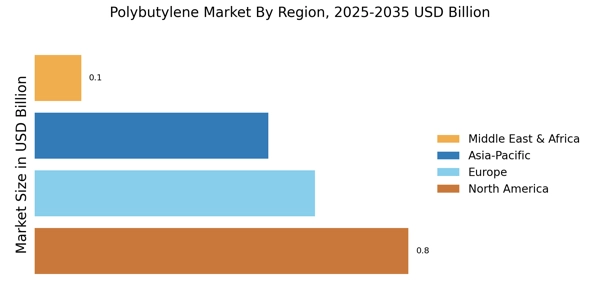Expansion of End-Use Industries
The expansion of end-use industries such as automotive, construction, and consumer goods is a critical driver for the Polybutylene Market. The automotive industry, which is increasingly incorporating polybutylene in components like fuel lines and connectors, is expected to grow steadily, with a projected market size reaching USD 3 trillion by 2026. Similarly, the construction sector is experiencing a surge in demand for polybutylene pipes due to their resistance to corrosion and low thermal conductivity. This trend is likely to enhance the overall market for polybutylene, as more industries recognize its benefits. The diversification of applications across various sectors indicates a robust future for the Polybutylene Market.
Rising Demand for Lightweight Materials
The increasing demand for lightweight materials across various industries is a notable driver for the Polybutylene Market. As manufacturers seek to enhance fuel efficiency and reduce emissions, the lightweight properties of polybutylene make it an attractive option for automotive and aerospace applications. The automotive sector, in particular, is projected to witness a compound annual growth rate of approximately 4.5% over the next few years, which could significantly boost the demand for polybutylene. Additionally, the trend towards lightweight construction materials in the building and construction sector further supports this growth. As companies strive to meet sustainability goals, the adoption of polybutylene is likely to rise, thereby propelling the Polybutylene Market forward.
Technological Innovations in Production
Technological innovations in the production of polybutylene are driving advancements within the Polybutylene Market. Recent developments in polymerization techniques have led to improved efficiency and reduced production costs, making polybutylene more accessible to manufacturers. Innovations such as the use of catalysts and advanced processing methods are enhancing the material's properties, which could lead to broader applications in various sectors. As production techniques continue to evolve, the Polybutylene Market is likely to benefit from increased supply and reduced prices, fostering greater adoption across multiple industries. This technological progress may also stimulate research and development efforts, further expanding the market.
Growing Awareness of Environmental Impact
The growing awareness of environmental impact is influencing consumer preferences and driving the Polybutylene Market. As sustainability becomes a priority for both consumers and manufacturers, the demand for eco-friendly materials is on the rise. Polybutylene Market, known for its recyclability and lower environmental footprint compared to traditional materials, is gaining traction. The construction industry, in particular, is increasingly adopting polybutylene products to meet green building standards. This shift towards sustainable practices is expected to propel the Polybutylene Market, as more companies seek to align with environmental regulations and consumer expectations. The potential for polybutylene to contribute to sustainable development is likely to enhance its market position.
Regulatory Support for Advanced Materials
Regulatory support for advanced materials is emerging as a significant driver for the Polybutylene Market. Governments are increasingly implementing policies that promote the use of innovative materials in various applications, particularly in construction and automotive sectors. These regulations often encourage the adoption of materials that enhance energy efficiency and reduce environmental impact. As a result, polybutylene, with its favorable properties, is likely to benefit from such supportive measures. The anticipated increase in funding for research and development in advanced materials could further bolster the Polybutylene Market, as it aligns with governmental objectives to foster innovation and sustainability.


















Leave a Comment